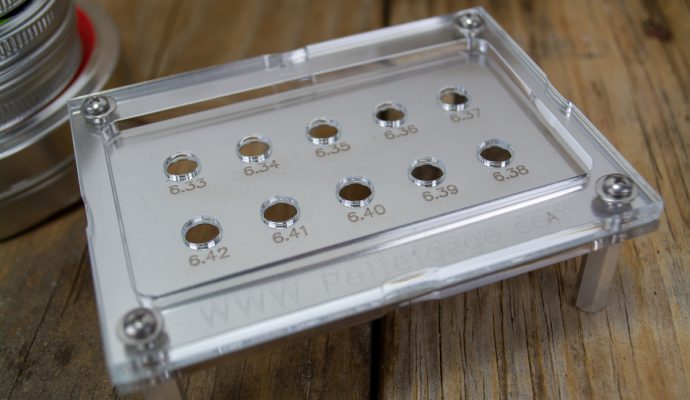
So, how big are your pellets?
If you’re like me, you may not know for sure. Until now, I’ve just trusted the box label to figure out if I’m shooting the right projectiles for a given airgun. That all changed when Jerry Cupples, the inventor of Pellet Gage reached out to me a couple of months ago.

Serious airgunners already know that sorting pellets for weight, shape, and size consistency yields optimal accuracy results. Jerry just made the process easier by creating a quick and easy-to-use sorting tool. The concept is one of those simple “why didn’t I think of that” ideas. Jerry drills a series of meticulously sized holes in a stainless-steel plate so you can drop pellets through to easily gauge pellet head size. If a pellet clears one hole but not the next, you know the pretty-darn-near-exact diameter of the pellet. The holes are sized with a tolerance of +/- 0.0025 mm (0.0001 in.) accuracy.

I asked for a sample of the .25 caliber Pellet Gage because I like big .25s and I cannot lie. This particular model of the Pellet Gage has laser-drilled holes in the following sizes: 6.33, 6.34, 6.35, 6.36, 6.37, 6.38, 6.39, 6.40, 6.41, and 6.42 millimeters. The kit arrives disassembled, but that’s just for shipping convenience. Putting it together took me a whopping 30 seconds, give or take. The only assembly task that required a second or two of care was making sure the acrylic guide plate holes lined up properly with the stainless sizing plate under.
Jerry sent along some usage tips. I’ll quote him here.
I suggest you start with the opening a bit larger than the expected nominal of your pellets. For instance, if you have 4.52 pellets, start with the 4.53 opening. The pellet should drop into the aperture, caught by the skirt. Pop it back up with your finger from underneath the gage. Then, move to the 4.52 and test to see if it drops. If it doesn’t – your pellet is between 4.52 and 4.53! It’s that simple. Let’s all agree – we will consider the size of the pellet to be the smallest diameter aperture that the pellet will clear.
With a bit of practice, it takes seconds to check a pellet. You will likely find (if you buy good pellets) that most of them will be within a few apertures up/down from some nominal size. The gauge will also reject an oval pellet, or one with a defect.

Sounds easy enough, right? I decided to test a couple of .25 pellet types to give it a try. My goal for the initial session was to take a random sampling of just ten pellets of each type to get a feel for variance. Once that’s done, I’m going to measure larger quantities of all these of pellets, group them by head diameter, then take them to the range and shoot for accuracy. It’ll be interesting to see if I can find size preferences for various air rifles. With that knowledge, when I want to shoot for maximum accuracy, I’ll rummage through pellet tins and sort out some piles of optimized pellets. Make sense?

I dug into three types of pellets I had handy for a quick test: H&N Sport Barracuda 30.86-grain, JSB Match Exact King Diabolo 25.39-grain, and H&N Sport Barracuda Hunter 27.47-grain hollow-points. To try out the process, I pulled 10 pellets from each tin and found the following measurements.
H&N Sport Barracuda 30.86-grain
6.37mm: (7)
6.38mm: (3)
JSB Match Exact King Diabolo 25.39-grain
6.37mm: (1)
6.38mm: (6)
6.39mm: (3)
H&N Sport Barracuda Hunter 27.47-grain hollow-point
6.36mm: (2)
6.37mm: (3)
6.38mm: (3)
6.39mm: (2)
As you might expect, the “match” and competition pellets were a little closer in tolerance than the hunting pellets.
I a couple of weeks, we’ll revisit this with part two of our experiment where we’ll sort some “like” pellets for accuracy testing at the range. Of course, that wouldn’t be any fun if we didn’t also shoot some groups with random diameter pellets. We’re looking forward to seeing how much accuracy difference we can measure by sorting our pellets by head diameter,. Stay tuned…




